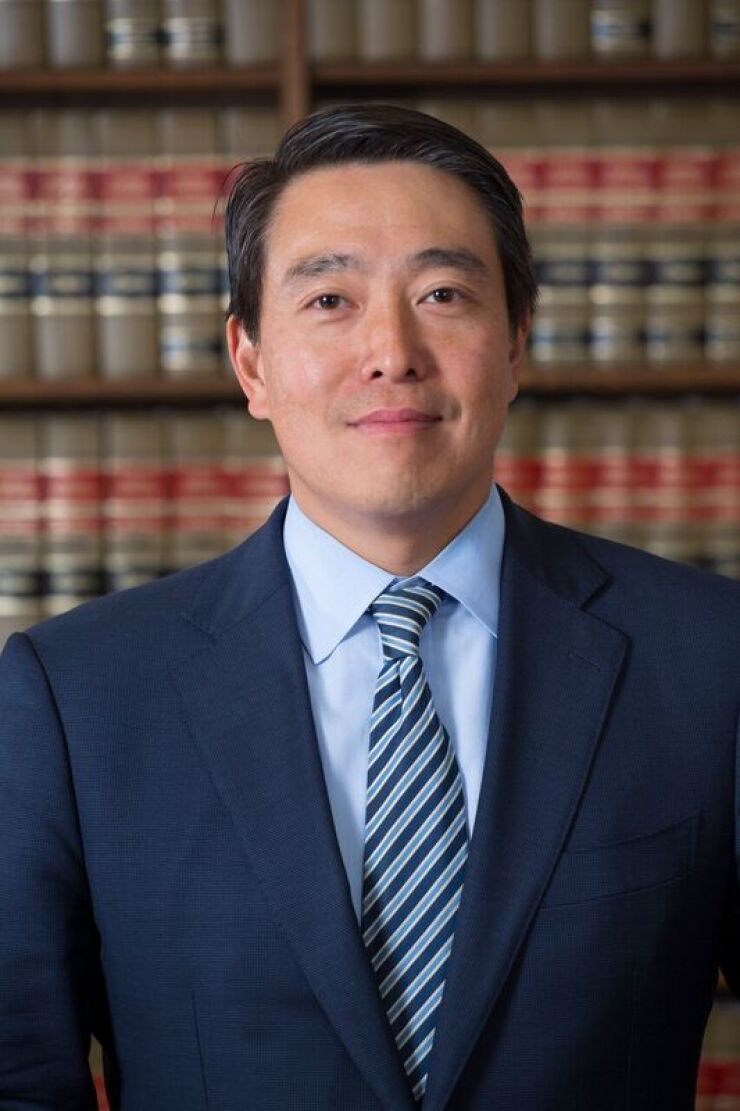In a first-of-a-kind action, a federal jury has found the former town supervisor for Ramapo, N.Y. guilty of 20 counts of conspiracy, securities fraud, and wire fraud in connection with municipal bonds the town and its development corporation issued.
The jury verdict against Christopher St. Lawrence is the first conviction for securities fraud in connection with municipal bonds, according to Joon Kim, the acting U.S. attorney for the Southern District of New York. The verdict came after a four-week trial in federal court in White Plains, N.Y. St. Lawrence was originally charged with 22 counts of wrongdoing but was acquitted on one count of securities fraud and one count of wire fraud.
Robert Doty, president of the municipal securities litigation consulting firm AGFS, said the new “first” in the municipal market is something important for issuers to consider.
“Now that the [Securities and Exchange Commission] and [Department of Justice] have begun to coordinate their efforts, this is another significant issue for municipal officials to keep in mind,” Doty said.
LeeAnn Gaunt, chief of the SEC’s public finance abuse unit, announced in April 2016 that the SEC would be increasing its coordination with DOJ and the Federal Bureau of Investigations, particularly in cases involving public corruption and pay-to-play.
The ultimate penalties St. Lawrence will face because of the verdict will be detailed in a yet-to-come judgment from U.S. District Court Judge Cathy Seibel, who sits on the U.S. District Court for the Southern District of New York and presided over the case. Each of the 11 counts of wire fraud and eight counts of securities fraud carry a maximum sentence of 20 years in prison while the single count of conspiracy carries a maximum sentence of five years in prison.
“As the jury found today after trial, Christopher St. Lawrence lied repeatedly to the investing public about the state of Ramapo’s finances,” Kim said in a DOJ release after the verdict. “The integrity of the $3.7 trillion municipal bond market is of critical importance to both investors and municipalities that rely on this market. The verdict today in a case of public corruption meets securities fraud, stands as a victory for both honest government and fair financial markets.”

The DOJ’s indictment of St. Lawrence largely mirrors a still-pending civil complaint the Securities and Exchange Commission filed against St. Lawrence and others associated with the town at the time of the indictment. Aaron Troodler, a former official with the Ramapo Local Development Corp. that issued two of the 16 bonds associated with the fraud, was also indicted but pleaded guilty to criminal securities fraud in March.
The DOJ found that Troodler and St. Lawrence lied to investors in the town's and RLDC's bonds, some of which were used to finance a minor league baseball stadium, in order to conceal the deteriorating state of Ramapo's finances and the inability of the RLDC to make scheduled payments of principal and interest to holders of its bonds from its own money.
Much of the fraudulent activity was designed to conceal the town's deteriorating general fund, which is Ramapo's primary operating fund and faced deficits ranging between $250,000 and $14 million between the town's fiscal years 2009 and 2014. As of August 2015, the town had more than $128 million in outstanding bonds that had been issued for various municipal purposes while the RLDC, which is owned by the town, had issued $25 million in bonds to pay for the minor league baseball stadium, according to the DOJ.
The fraud preceded the construction of the baseball stadium, but the $58 million total cost of the stadium played a role in the town's financial problem, the DOJ said. Ramapo paid more than half the cost, even though the town's citizens rejected paying for the stadium through bonds in a 2010 referendum and St. Lawrence publicly stated that no public money would be used.
St. Lawrence also lied to the RLDC's bond rating service in 2013 when he said the 2012 general fund balance would remain unchanged from the 2011 balance, according to the DOJ. After that conversation, St. Lawrence reportedly told town employees "we're going to have to all be magicians to get some of those numbers."
Troodler and St. Lawrence also told investors that Ramapo and the RLDC's bonds were being paid using operating revenue drawn from things like running the baseball stadium and selling condominiums. In reality, the RLDC was making payments using money Troodler either borrowed from the bank or got from the town, according to the indictment.
Much of the cover-up involved keeping fake receivables on the town's books that kept the general fund from showing a negative balance, the DOJ said.
Additionally, St. Lawrence made more than $12 million in transfers from Ramapo's ambulance fund to the general fund from 2009 to 2014. The two funds had different tax bases and such transfers should only have been made as loans, according to the indictment.





